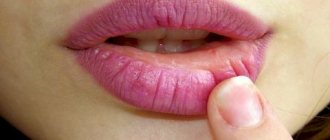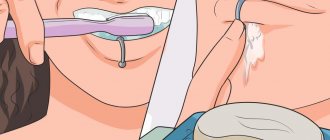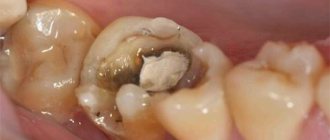Reasons for the development of cheilitis
The main causes of the disease include:
- Dermatoses seem to be the most common cause of cheilitis. Skin diseases such as psoriasis, lupus erythematosus, syphilis, tuberculosis, lichen, also often provoke inflammation of the red border of the lips.
- Thyroid diseases.
- Allergies to various kinds of external factors, professional activities.
- Adverse weather conditions.
- Hereditary predisposition.
- Decreased immunity, gastrointestinal diseases.
How to deal with the problem
To eliminate sticky lips, it is first very important to find out the cause of this condition. If this is an allergic reaction, it is necessary to avoid contact with the potential irritant. Next, the doctor prescribes antihistamines - suprastin, tavegil, claritin, diazolin, cetrin. External treatment is carried out using hypoallergenic moisturizers.
If the cause is the negative impact of climatic conditions, it is important to regularly use nourishing balms, moisturizing lipsticks that contain natural oils, petroleum jelly, lanolin and paraffin, as well as photo filters.
If there is a lack of vitamin substances, the doctor will prescribe certain multivitamin complexes that compensate for the deficiency of these substances. It is also necessary to balance your diet so that your daily menu includes vegetables and fruits.
If an infectious process is diagnosed, the doctor may prescribe additional corticosteroids, antibacterial drugs, and antifungal agents. It is not recommended to use any medications on your own, so as not to aggravate the situation and not to mask the main cause of the unpleasant symptom.
Proper lip care is important:
- Applying moisturizers.
- Treatment with nourishing cosmetics.
- Protection before leaving the premises.
- Massage with a toothbrush to improve blood circulation and skin condition.
Types of cheilitis
All types of cheilitis are divided into two groups:
- symptomatic (cheilitis, as a manifestation of the underlying disease);
- true (as an independent disease).
Types of symptomatic cheilitis and their clinical manifestations
The symptomatic group includes the following types of cheilitis:
- Eczematous - develops against the background of eczema, characterized by redness, swelling, burning and pathological changes in the skin of the lips. If left untreated, it becomes chronic.
- Macrocheilitis - this form of cheilitis is considered a component of Melkersson-Rossolimo-Rosenthal syndrome. There is severe itching and swelling of not only the lip, but also other parts of the face.
- Atopic - a predisposition to allergies to medications and food is a prerequisite for the development of inflammation. It manifests itself as peeling, redness, itching of the skin of the lips, and the formation of cracks in the corners of the mouth.
How to get rid of dry lips at home
Sour cream mask
Mix a teaspoon of lemon juice and sour cream, and also add a little vegetable oil to the mixture. Regularly apply the product to the lips and surrounding area for 20 minutes, then rinse with warm water.
Honey lip massage
Rub a small amount of honey into your lips with light massaging movements or apply it to the corners of your lips if necessary. You can use this mask as often as you want.
Baby cream to help you
Apply a high-quality baby cream to your lips in a thick layer. After 15 minutes, simply blot off any remaining product with a clean napkin.
Vegetable oils for lips
You can also use sea buckthorn, almond, and wheat oils. Such oils are applied to the lips twice a day, and a couple of drops of vitamins A or E are often added to them to enhance the effect.
Types of true cheilitis
True cheilitis includes:
- Contact - manifests itself as a result of the body’s reaction to contact with an irritant: cosmetics (determined mainly in women), the bad habit of holding a pen or pencil in the mouth, professional activity (musicians due to prolonged use of the mouthpiece of a wind instrument) Characterized by redness, itching, feeling burning, swelling of the lips.
- Actinic - involves the development of an inflammatory process as a result of special sensitivity to natural phenomena: sunlight, wind, frost, radiation. It manifests itself as small blisters or erosion, swelling of the red border. This type of cheilitis is also called meteorological.
- Exfoliative - occurs mainly in women. The development of pathology occurs against the background of depression, anxiety, and various disorders of the nervous system. The main symptoms are dryness, severe, prolonged peeling of the lip border. Exfoliative cheilitis has two forms: dry and exudative. With exudative inflammation, crusts form, causing pain in the patient.
- Glandular - occurs against the background of hypertrophy of the minor salivary glands. This phenomenon can be congenital (appears after puberty) or acquired as a result of chronic inflammation. There is a risk of suffering from glandular cheilitis in people with periodontal disease, numerous carious cavities, after lupus erythematosus, and leukoplakia. It is initially characterized by increased dryness, which does not disappear with the use of hygiene products. Later - the presence of cracks due to the constant exposure of saliva to the red border of the lips. 20-30% of patients with glandular cheilitis develop squamous cell carcinoma. It is necessary to take a responsible approach to the treatment of this disease and seek qualified help from doctors in a timely manner - surgical intervention may be required.
Prognosis and prevention
With timely treatment and the absence of malignancy processes, the prognosis is almost always favorable. If the therapy has caused noticeable cosmetic defects, you can resort to methods for correcting the appearance of the lips.
To prevent complications, it is important to understand whether you are at risk. The presence of allergic diseases and dermatoses, chronic endocrine diseases, and wearing dentures increase the risk of developing pathology. To prevent the appearance of cheilitis, it is important to adhere to several rules:
- regularly visit the dentist, sanitize the oral cavity, remove tartar;
- promptly replace outdated fillings and orthopedic structures, contact after chipped teeth and injuries to prevent lip injury from the sharp edges of fillings and enamel;
- For the manufacture of prostheses, contact only professionals;
- eat properly and nutritiously to prevent hypovitaminosis;
- try to avoid prolonged exposure to the sun and use products with SPF, including for lips;
- be attentive to your health and promptly treat diseases of the gastrointestinal tract, endocrine, nervous system, and internal organs.
Treatment of cheilitis
This disease requires special treatment, depending on the cause, type and degree of the inflammatory process. The main methods of treating cheilitis:
- local treatment of the surface of the skin of the lips with disinfectant solutions, ointments, vitamin oil solutions;
- physiotherapeutic methods: Bucca radiation, ultrasound, laser therapy;
- a course of vitamin therapy;
- rinsing the mouth with decoctions of medicinal herbs.
If necessary, to eliminate the causes of the disease, specialized specialists may be involved: a dermatologist, an allergist, an infectious disease specialist.
Expert opinion
- Cosmetologist
- Surgeon
Michelle Ellern
practicing cosmetologist-dermatologist
Dry lip skin, covered with cracks and crusts, does not look very pleasant and brings a lot of discomfort. To get rid of the deficiency and restore health and beauty to the skin, you can use salon methods, pharmaceutical preparations, as well as folk recipes. It is in combination that you can get an excellent effect. Proper daily care will help prevent problems from occurring.
Theda Contis
plastic surgeon
The skin on the lips is very thin and delicate and reacts sharply to any irritants.
Negative influences in the form of temperature changes, weather or stress cause harm to sensitive skin. Dry skin on the lips and around the mouth is a serious drawback that can greatly ruin your appearance. For complete elimination, you need to consult a specialist. It is better to entrust the choice of the appropriate method to a cosmetologist. Caring manipulations will protect the sensitive skin of the lips from the negative effects of many factors, maintaining its health and attractiveness.
It is easier to prevent a deficiency from occurring than to fight it later in every possible way.
Allergic cheilitis
A disease that develops in allergy sufferers upon contact with an allergen and affects the surface of the lips. Typical manifestations of this type of cheilitis are a feeling of itching and burning on the lips, dryness and significant discomfort. The lips begin to dry and peel, and the scales of dead epithelium begin to flake off.
The main cause of this disease is the patient’s increased sensitivity to external irritants, in particular to allergens. Allergic, or, as it is also called, contact cheilitis can develop gradually.
It all depends on the patient’s personal sensitivity to allergens, and it can develop over several weeks, months and even years. The duration of this process is determined by the peculiarities of the endocrine system, as well as the degree of manifestation of allergic reactions.
This disease practically does not appear in children. According to statistics, most patients with allergic cheilitis are women over twenty years of age.
Causes of the disease
In most cases, allergic cheilitis is caused by contact allergic irritants. Among the most common allergens that cause cheilitis is lipstick. It is not the lipstick itself that is dangerous, but the substances it contains - rhodamine, eosin and others. Provoking factors also include low-quality dental implants and plastic dentures.
Allergic manifestations may appear after contact with citrus fruits, as well as in patients who have the habit of chewing pencils or pens. The disease is also common for those whose work involves playing wind instruments or hazardous chemical production.
Symptoms of the disease
The disease manifests itself as hyperemia and swelling of the lips, as well as a sensation of itching and burning, accompanied by the formation of erythema. Small painful blisters appear and burst on the affected areas of the lips. If the pathogenic process is prolonged, over time, small scars and scars will form in their place on the lips. Dry lips only increase over time.
Inflammation almost never extends beyond the red border around the lips. In rare cases, it may spread to adjacent skin. Sometimes the inflammatory process moves to the oral mucosa. This form of allergic cheilitis is characterized by hyperemia (significant redness of the tissues), the appearance of noticeable swelling of the tissues, and when trying to palpate, pain occurs.
Diagnosis and treatment
Diagnosis of the disease is carried out by a dentist together with an allergist. To determine the allergen, it is necessary to conduct allergy tests.
When making a diagnosis, it is important to distinguish allergic and atopic cheilitis, as well as exclude exfoliative and actinic cheilitis. Treatment of this disease includes the mandatory elimination of the irritant or allergen that caused it.
Systemic (general) and topical (local) drug therapy is used. General therapy refers to the use of medications taken orally. To relieve allergy symptoms, a course of antihistamines is used. If the case is sufficiently complex, the use of corticosteroids may be indicated. In addition, calcium supplements may be prescribed.
Local treatment of allergic cheilitis includes the use of a variety of emollient oils, ointments and balms based on sea buckthorn, vitamin E and others. To avoid the recurrence of the pathology, it is necessary to take an allergy test in order to eliminate any contact with the allergen in the future. It is also advisable to reconsider your diet and carefully consider the choice of cosmetics.
Traditional recipes (5 best options)
If dry lip skin begins to crack in winter, you need to urgently decide what to do about such an annoying drawback.
You can use the tools that are found in every home:
- Vaseline and castor oil. A cotton swab is soaked in castor oil, then it must be carefully passed over the lips. Vaseline is spread over the top with a thin layer. To restore damage, the procedure is repeated for 7 days.
- Honey. Apply to the skin with a finger previously moistened with water to prevent the product from sticking. Honey can kill germs, moisturize, and saturate tissues with nutrients.
- Aloe vera. This popular plant is valued for its unique medicinal properties. You can apply gel with aloe extract to your lips or apply a juicy leaf. Especially relevant for use in cases of increased dryness and sunburn.
- Butter without salt. Another safe natural moisturizer. It is enough to lightly rub your lips with a slice of butter twice a day. If the product contains salt, it will harm your skin.
- Water. One of the reasons for excessive dryness of the face and lips may be dehydration of the entire body. This means that a person does not drink enough drinking water. It is impossible to make up for the deficiency with soda, tea, coffee or juice. Sometimes the listed drinks lead to the opposite effect. To restore water balance, you need to drink at least 1.5 - 2 liters of water per day.
If all the remedies have been tried and there is no positive result, it’s time to visit a doctor. Perhaps the cause of dryness lies in anemia or lack of iron.
Vegetarians often suffer from such disorders, because the main source of this microelement is meat.
Signs of iron deficiency are chronic fatigue, frequent headaches, deep cracks and peeling on the lips.
To compensate for the deficiency of essential substances, you should take vitamin complexes containing iron.
Another way to treat dry lips is to use humidifiers. Clean, enriched air is good for health and has a beneficial effect on appearance.
Preventive actions
To minimize the risk of unpleasant symptoms and deterioration of skin condition, you must follow simple rules:
- eat a balanced diet;
- observe drinking regime;
- treat underlying diseases in a timely manner;
- protect skin from ultraviolet exposure;
- control your habits and actions - do not lick or bite your lips; make sure that the child does not do this;
- cope with stress;
- use hypoallergenic, high-quality cosmetics for lip care.
Chief author and editor-in-chief: Makarskaya S.E., 29 years of experience.
Last revision: 01/10/2019










